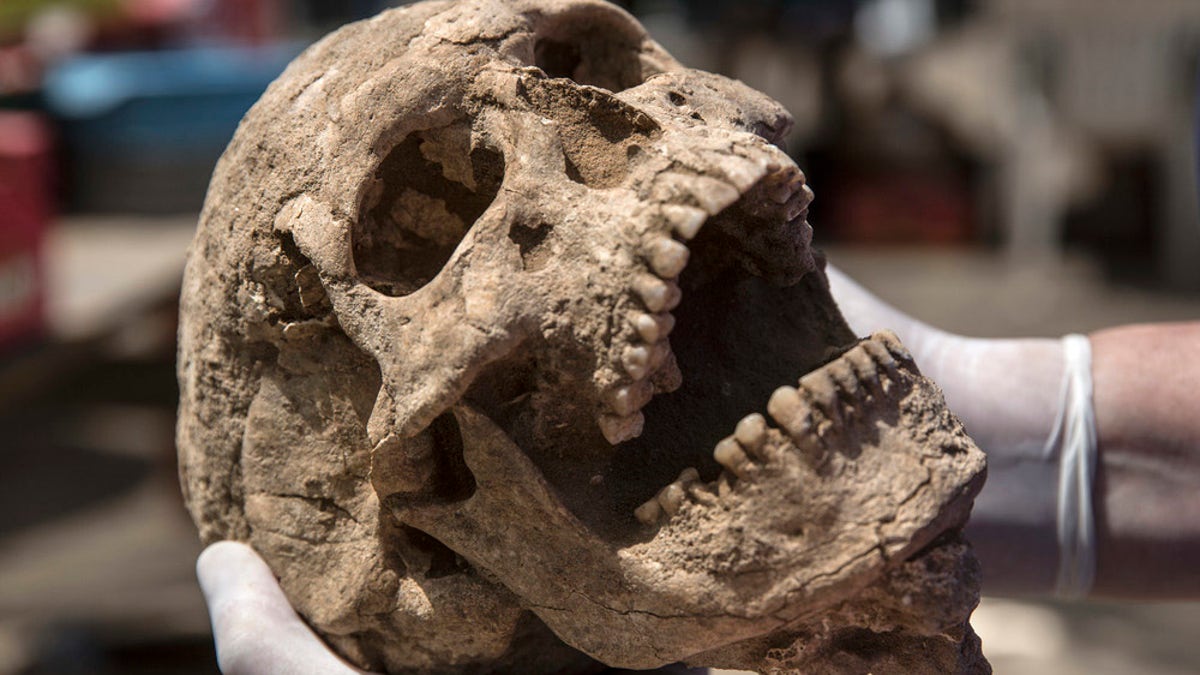
(Tsafrir Abayov/Leon Levy Expedition)
Earlier this year it was reported that the first–ever Philistine cemetery was discovered on the Israeli coast near Ashkelon. Now, the contents of the 3,000 year–old graveyard have been revealed.
Burial practices of the mysterious group, famous for their conflicts with the Israelites in the Bible and whose geographic origins remain unknown, has been a much–debated topic among scholars for decades.
“We are still working to understand the identity and origins of the Philistines,” excavation leader Adam Aja of the Harvard Semitic Museum told Foxnews.com. “The study of burial practices and the skeletal remains will contribute significantly to this picture, but this will only be a part of it.”
UNDERWATER HEBREW TABLET REVEALS BIBLICAL-ERA RULER OF JUDEA
The discovery, however, has also drawn criticism with some experts not associated with the excavation questioning the identity of the people buried at the cemetery.
The cemetery near Ashkelon, an area long associated with the ancient non–Semitic people, was discovered below a huge overburden of soil just outside of the settlement’s walls. Being buried beneath massive layers of soil is, in Aja’s opinion, part of the reason Philistine cemeteries have remained undiscovered for so long.
While the total size of the burial ground is unknown, the excavated area measures 65 x 98 feet and holds the remains of 227 Philistines, according to Aja. For a small area it has a very high burial density, with two buried individuals per ten square feet.
The dead Philistines’ ages ranged from infants to senior adults, and were buried in several different ways.
ARCHAEOLOGISTS UNEARTH FISHERMAN'S HOUSES IN ISRAEL
“I was impressed by the variety of burial types,” Aja said. “We found stone tombs, children buried under sherds [fragments of pottery] or face down, pit graves, and cremations [in sealed jars]. This reveals that there was not a single burial practice for this population.”
Most of the bodies were buried in shallow graves along with jugs and small containers that may have held perfume.
Aja believes that the jar, bowl, and juglet assemblage that accompanied many skeletons may have been part of a wine drinking set. “It is unclear if this was intended for use by the dead, or as part of the burial ceremony for the living,” he said.
Some of the men were buried with ornamental beads or engraved stones, while most of the women and children’s remains had on jewelry– earrings, rings, and bracelets that were generally made of bronze or beads.
BIG DISCOVERY COULD REVEAL THE TRUE STORY OF THE PHILISTINES
Aja says he was most pleased to see how the jewelry was worn.
“I have often found single beads in my excavation of settlements, but it was exceptional to find the full strung necklace, bracelet, or anklet still intact on the bodies,” he said.
Many of the bodies showed signs of physiological and biological stress, which affected their growth and development. The Ashkelon dead were relatively short: men averaged 5’1”, women 4’10”. The small difference in height between genders is a sign of population–wide malnourishment. There were growth interruptions in many individuals’ teeth, indicating fever and malnutrition among other possible biological disorders.
8-YEAR-OLD 'YOUNG INDIANA JONES' DISCOVERS ANCIENT ARTIFACT NEAR JERUSALEM
And while the Philistines were a notoriously fierce people, none of the skeletal remains found showed signs of death in battle (though the team did find a set of iron arrows near a man’s hip).
DNA testing should a little more light on the deceased Philistines’ health and causes of death.
“Among other things, we hope to add details regarding the health of individuals based upon our study of the bone, and population parallels based upon DNA evidence, but it is still too early to say much about these things,” Aja said.
The team also found eight stone burial chambers, with the largest one holding 23 skeletons. The chambers were lined up in three rows running parallel to the coast.
There is hope that this is only the tip of the iceberg and that there’s a lot more cemetery to be excavated.
FIRST EVER? DISCOVERY OF PHILISTINE CEMETERY DRAWS CRITICISM
“It is uncertain what constrained our cemetery, forcing such an overuse of each square meter of soil,” Aja said. “It was never clear whether the cemetery was circumscribed so that all burials were forced into a particular plot or whether the burials were clustered around some feature in the landscape. In either case, if this measured density was extrapolated across just the excavated areas, the number of burials would top 1200 persons.”
He expects that the cemetery was much larger, and if it approached the maximal boundaries suggested by other evidence (over 260 feet long), the number of buried individuals would be several times larger.
The team is currently waiting on the results from DNA analysis of the skeletons, which could finally reveal where the Philistines originated.
